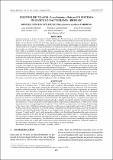Por favor, use este identificador para citar o enlazar este ítem:
https://hdl.handle.net/20.500.12958/8271Registro completo de metadatos
| Campo DC | Valor | Lengua/Idioma |
|---|---|---|
| dc.contributor.author | Gonzales Molina, Luis | - |
| dc.contributor.author | Ganoza Chozo, Francisco | - |
| dc.contributor.author | Prieto Dueñas, Cruz | - |
| dc.contributor.author | Alvarez Veliz, Jhon | - |
| dc.contributor.author | García Valladares, Jean | - |
| dc.contributor.author | Corasma Bartolo, Rosmery | - |
| dc.contributor.author | Barreto Meza, Jesús | - |
| dc.date.accessioned | 2023-10-02T16:05:01Z | - |
| dc.date.available | 2023-10-02T16:05:01Z | - |
| dc.date.issued | 2023-09 | - |
| dc.identifier.citation | Gonzales Molina, L., Ganoza Chozo, F., Prieto Dueñas, C., Alvarez Veliz, J., García Valladares, J., Corasma Bartolo , R. & Barreto Meza, J. (2023). Cultivo de tilapia Oreochromis niloticus en sistema de floculo bacteriano – Biofloc. Inf Inst Mar Perú, 50(3), 410- 420. | es_ES |
| dc.identifier.issn | 0378-7702 | - |
| dc.identifier.uri | https://hdl.handle.net/20.500.12958/8271 | - |
| dc.description.abstract | Este trabajo se realizó en el Laboratorio Costero de Imarpe – Huacho, durante cuatro meses, con la finalidad de cultivar juveniles de tilapia, alimentadas con plancton mediante el sistema biofloc. Se emplearon los procedimientos de maduración del biofloc, acondicionamiento y crecimiento de juveniles, se evaluaron los procesos de conversión de compuestos nitrogenados (nitrógeno amoniacal total, NO2 y NO3) y su relación con las variables físicas y químicas que influyeron en la estabilidad del crecimiento del alimento natural. Se acondicionaron 300 juveniles de tilapia Oreochromis niloticus, en 3 tanques de 2 m3. La etapa experimental se dividió en autotrófica y heterotrófica; esta última fue especialmente controlada mediante la adición de bicarbonato de sodio y melaza como fuentes de alcalinidad y carbono orgánico, respectivamente (relación C: N de 10:1). Al inicio los ejemplares tuvieron longitud y peso promedio de 6,12 cm y 4,14 g, al final del experimento alcanzaron 17,38 cm y 96,08 g. La alcalinidad del cultivo estuvo entre 100 y 150 mg/L mediante la adición de bicarbonato de sodio (250 g por 1 m3). El oxígeno fue saturado y continuo, varió entre 7,5 mg/L y 8,5 mg/L; se conservaron los sólidos en suspensión distribuidos en toda la columna de agua para ser filtrados por los peces. El pH permaneció estable por debajo de 11. Los resultados permitieron concluir que el sistema biofloc, generó el crecimiento de los organismos del plancton, que sirvió como alimento natural de calidad. Como resultados, a las tilapias se les redujo la adición del alimento comercial, disminuyendo el factor de conversión alimenticia, obteniendo ganancia en peso; además los parámetros fisicoquímicos del agua con cero recambios se mantuvieron en condiciones apropiadas para el cultivo de juveniles de tilapia. | es_ES |
| dc.description.abstract | ABSTRACT: This study, conducted at the Imarpe’s Coastal Laboratory in Huacho over four months, aimed to cultivate juvenile Oreochromis niloticus using a biofloc system that relies on plankton as a primary food source. The research encompassed biofloc maturation, juvenile conditioning, and growth evaluation while considering the conversion of nitrogenous compounds (total ammonia nitrogen, NO2, and NO3) and their correlation with physical and chemical factors influencing natural food stability. Three hundred juvenile O. niloticus were conditioned in three 2 m3 tanks. The experimental phase comprised autotrophic and heterotrophic stages, with the latter being meticulously regulated through the addition of sodium bicarbonate and molasses as sources of alkalinity and organic carbon, respectively, maintaining a C:N ratio of 10:1. Initial specimens had an average length and weight of 6.12 cm and 4.14 g, respectively, and during the final stage of the study, they exhibited a noticeable growth, reaching an average length and weight of 17.38 cm and 96.08 g, respectively. Alkalinity levels in the culture ranged between 100 and 150 mg/L, achieved through the addition of sodium bicarbonate (250 g per 1 m3). Oxygen levels remained consistently saturated, fluctuating between 7.5 mg/L and 8.5 mg/L, with suspended solids evenly distributed throughout the water column to facilitate filtration by the fish. The pH levels remained stable, consistently below 11. Our findings indicated that the biofloc system effectively promoted the growth of planktonic organisms, serving as a high-quality natural food source. Consequently, the addition of commercial feed was reduced, resulting in improved feed conversion ratios and weight gain. Furthermore, physicochemical water parameters remained suitable for the cultivation of juvenile O. niloticus, even in the absence of water exchange. | - |
| dc.language.iso | spa | es_ES |
| dc.publisher | Instituto del Mar del Perú | es_ES |
| dc.rights | info:eu-repo/semantics/openAccess | es_ES |
| dc.rights.uri | https://creativecommons.org/licenses/by/4.0/ | es_ES |
| dc.source | Instituto del Mar del Perú - IMARPE | es_ES |
| dc.source.uri | Repositorio Digital IMARPE | es_ES |
| dc.subject | Cultivo | es_ES |
| dc.subject | Biofloc | es_ES |
| dc.subject | Juveniles de tilapia | es_ES |
| dc.subject | Oreochromis niloticus | es_ES |
| dc.title | Cultivo de tilapia Oreochromis niloticus en sistema de floculo bacteriano – Biofloc | es_ES |
| dc.title.alternative | Biofloc system applied to Oreochromis niloticus farming | es_ES |
| dc.type | info:eu-repo/semantics/article | es_ES |
| dc.publisher.country | Perú - Callao | es_ES |
| dc.subject.ocde | http://purl.org/pe-repo/ocde/ford#1.06.12 | es_ES |
| Aparece en las colecciones: | Informe vol. 50(3) 2023 | |
Ficheros en este ítem:
| Fichero | Descripción | Tamaño | Formato | |
|---|---|---|---|---|
| Informe 50-3 artículo6.pdf | 881,59 kB | Adobe PDF |  Visualizar/Abrir |
Este ítem está sujeto a una licencia Creative Commons Licencia Creative Commons

